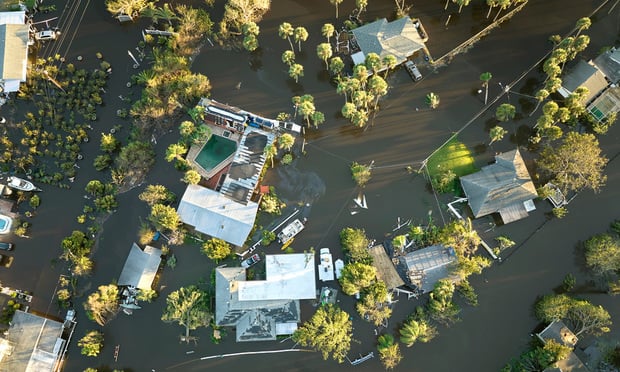It should not surprise anyone, least of all those in the insurance industry, that settling the many thousands of Hurricane Katrina-related homeowners' claims would not be as simple and straightforward as the language of their claims suggests. But one particular legal decision has produced another sort of hurricane that is already unsettling carriers and has the potential to damage homeowners as well. The eye of that storm is directly over the state of Mississippi, and it has knocked a critical clause in the standard homeowners' policy right off its foundation.
In Aug. 2006, Judge L.T. Senter of the Federal Court for the Southern District of Mississippi ruled on a lawsuit brought by Paul and Julie Leonard against Nationwide, which had issued their homeowner's policy. The case essentially came down to the question of whether or not the carrier was legally obliged to compensate the plaintiffs for flood damage (they did not have federal flood insurance coverage). The judge found that the terms of the policy “specifically exclude coverage for damage caused by water (with the specific and limited exception of water damage caused by rain that enters an insured structure after its watertight integrity has been lost through the action of the wind).” And he concluded, as a matter of law, that this and related provisions “are valid and enforceable terms of the insurance contract.”
Score One for the Insurer
But Judge Senter came to another conclusion as well: “The provisions of the Nationwide policy that purport to exclude coverage entirely for damages caused by a combination of the effects of water (an excluded loss) and damage caused by the effects of wind (a covered loss) are ambiguous.” He noted further that the policy provides “explicitly for windstorm coverage,” and at the same time excludes windstorm when it occurs concurrently with flooding. “The most reasonable interpretation for these conflicting policy provisions is that this policy provides coverage for windstorm damage,” wrote Senter. “That coverage is not negated merely because an excluded peril … occurs at or near the same time.” Finally, he assigned to the plaintiffs the burden of proving that there was windstorm damage to their home and to Nationwide the burden of proving what portion of the total loss was attributable to water damage.
In January, another case, also heard by Judge Senter, was brought by the Broussards against State Farm. Here, too, the judge found that the insurer was not obligated to pay for flood damage, but that when wind and water both damaged a home, it was the burden of the insurance company to prove the extent of the loss attributable to water and to pay for any wind damage.
To clarify and expand upon the implications of these cases, including their potential long-term effects, Claims turned to attorney Jay Brown, partner of the law firm Beirne Maynard & Parsons and co-chair of the firm's Insurance Litigation/Coverage section.
What is the legal significance of the Leonard case?
In the beginning, everyone was speculating as to whether Judge Senter and other judges would uphold the classic flood exclusion that has been relied upon as legal precedent for decades. He did — at first. And everybody in the [insurance] industry breathed a sigh of relief. But buried within that ruling, he ruled against the so-called “anti-concurrent causation” clause. Basically, that clause says, “Look, if it's both wind and water damage, and if water damage plays any role whatsoever, none of it is covered.” That's very common in the language of property policies to have that kind of exclusion. But Senter threw that out; he said it is ambiguous. Once he did that, now you have a fact issue: How much was wind? How much was water? By ruling against the anti-concurrent cause issue, he opened Pandora's Box.
Why did Senter assign the burdens of proof as he did?
First, you have to understand that once a judge finds ambiguity in the language of a policy, he has to rule against the insurance company because it's “their” policy. That is actually a legal fiction; in most jurisdictions, the state writes the homeowners' policies, not the carrier. The forms are all standard. But it's like in baseball, where the tie goes to the runner. It's got to go somewhere because the law doesn't like open-endedness.
Typically, the insured has the burden of proof initially to show that they come within the overall coverage of the policy, then the insurance company has to prove that one or more exclusions apply. In this case, it's an issue of allocating a percentage of the cause, and therefore of the damage, to wind and to water. When you have concurrent causation, different states have different approaches. Evidently, Senter felt that the carrier had the burden of making the allocation.
Under any circumstances, it seems it would be difficult to determine for certain damages that were caused by wind or by flood. With Katrina, where some houses were completely destroyed, how could that be done?
That burden is very hard to meet. Under any circumstance, how do you prove what percentage of damage was caused by wind? Usually, with a house that's been severely damaged, there's going to be some physical forensic evidence that will support one side or the other. It boils down to a fact issue, and often is a case of dueling experts. And usually, someone is there to say, “The light was red” or “No, it was green.” There weren't a whole lot of people standing around in a surging storm watching their houses being destroyed.
There was another case that came before Judge Senter in January, this one brought by the Broussards against State Farm. Whereas the Leonard case seems only to have asked for compensation for wind-related damage, Broussard included punitive damages. And it also appears to begin where Leonard left off — with the judge's rejection of the anti-concurrent causation language.
From what I've read, it sounds as if the judge put State Farm in a box with his [previous] ruling against the concurrent cause language. That gave State Farm the very difficult burden of proving that 100 percent of the damage was due to an excluded cause. And that was made even harder because nothing was left of the Broussard home except the foundations.
What was unusual here is that Senter rendered what is effectively a directed verdict with respect to compensatory damages. I suspect he decided that the evidence was so overwhelming against State Farm that no reasonable jury could find in the insurance company's favor. It also sounds as though the judge felt there was an absence of credible testimony by State Farm, since he also ruled that the carrier did not offer adequate evidence at trial to meet the burden of allocation.
Some people in the industry are saying that Judge Senter favors the policyholders, both because of the ruling against the anti-concurrent cause language and because he has remanded at least one case to the state court. Do you agree?
You have to look at all his rulings together. Remember, he first ruled that the flood exclusion is valid. You can only interpret that as favorable for insurers. Then he grants a directed verdict in favor of the plaintiffs and sends the punitive damages question to the jury. When the jury came back with $2.5 million in punitive damages, he ordered a remititur, reducing the award to $1 million. He also didn't say that insurers can't have an anti-concurrent causation clause in their policies; he said that the language doesn't do what the insurers thought it did. It's the language he objected to, not the principle. So based on these rulings, I don't think it's fair for anyone to characterize Judge Senter as pro-policyholder or pro-insurer.
To what extent are the Mississippi rulings likely to affect homeowners and the industry overall?
It's certainly going to cause insurers and underwriters some concern as to whether it will force them to abandon, or seek to abandon, that same language in other states, or whether it's going to force them to charge a higher premium for that same language in other states. Anti-concurrent cause exclusions have been in insurance policies for decades. It's a very common approach … when insurance companies expect to have tremendous problems of proving what caused something. Now there's some obvious risk associated with that language because a court — and not just some rogue court — has thrown it out. So in Mississippi, at least, the insurance companies will have to ask for changes in the policy language, or they will have to charge a tremendous premium for the risk to which the language exposes them.
Are the implications for the insurance industry as serious as the various news accounts and industry statements seem to suggest?
I don't think it's as serious for the insurers as it is for homeowners. Take Texas, for example, and the foundation and mold claims. Foundation claims were a cottage industry in Texas for many, many years; many law suits were filed, many court decisions were rendered. Ultimately, the language of the insurance policies changes to exclude certain causes of damage for foundations. The whole scenario played out again recently with mold. Now, after the boom in mold-related litigation, the insurance companies have gone back to the state regulatory authorities, who have approved different forms that very clearly exclude mold damage. A homeowner can buy a very limited amount of mold coverage, but it costs a pretty penny indeed. Over the last several years, homeowners' premiums have doubled, but there's less coverage. I think the same thing will play out in Mississippi.
What about a carrier pull-out from Mississippi?
Well I think the insurance companies are going to take a hard look at things. If they think they can make a reasonable profit, they'll stay — if they can get the language changed and the premiums [raised] to where they believe it will cover what they believe to be an environment of enhanced risk.
State Farm recently announced that it will stop writing new homeowners' policies in Mississippi, saying that “the legal and business environment … is becoming more unpredictable.” Are they discounting the possibility of changing the policy language?
That takes time. It took years for the Texas authorities to allow insurers to change their language. In Mississippi, it could be a huge political issue, which slows things down even more. After a year of non-renewals, an insurer has basically pulled out. A lot more [companies] are going to pull out. Some will remain, but in the years to come, homeowners in Mississippi will be paying a lot more for less coverage.
Want to continue reading?
Become a Free PropertyCasualty360 Digital Reader
Your access to unlimited PropertyCasualty360 content isn’t changing.
Once you are an ALM digital member, you’ll receive:
- Breaking insurance news and analysis, on-site and via our newsletters and custom alerts
- Weekly Insurance Speak podcast featuring exclusive interviews with industry leaders
- Educational webcasts, white papers, and ebooks from industry thought leaders
- Critical converage of the employee benefits and financial advisory markets on our other ALM sites, BenefitsPRO and ThinkAdvisor
Already have an account? Sign In Now
© 2024 ALM Global, LLC, All Rights Reserved. Request academic re-use from www.copyright.com. All other uses, submit a request to [email protected]. For more information visit Asset & Logo Licensing.








